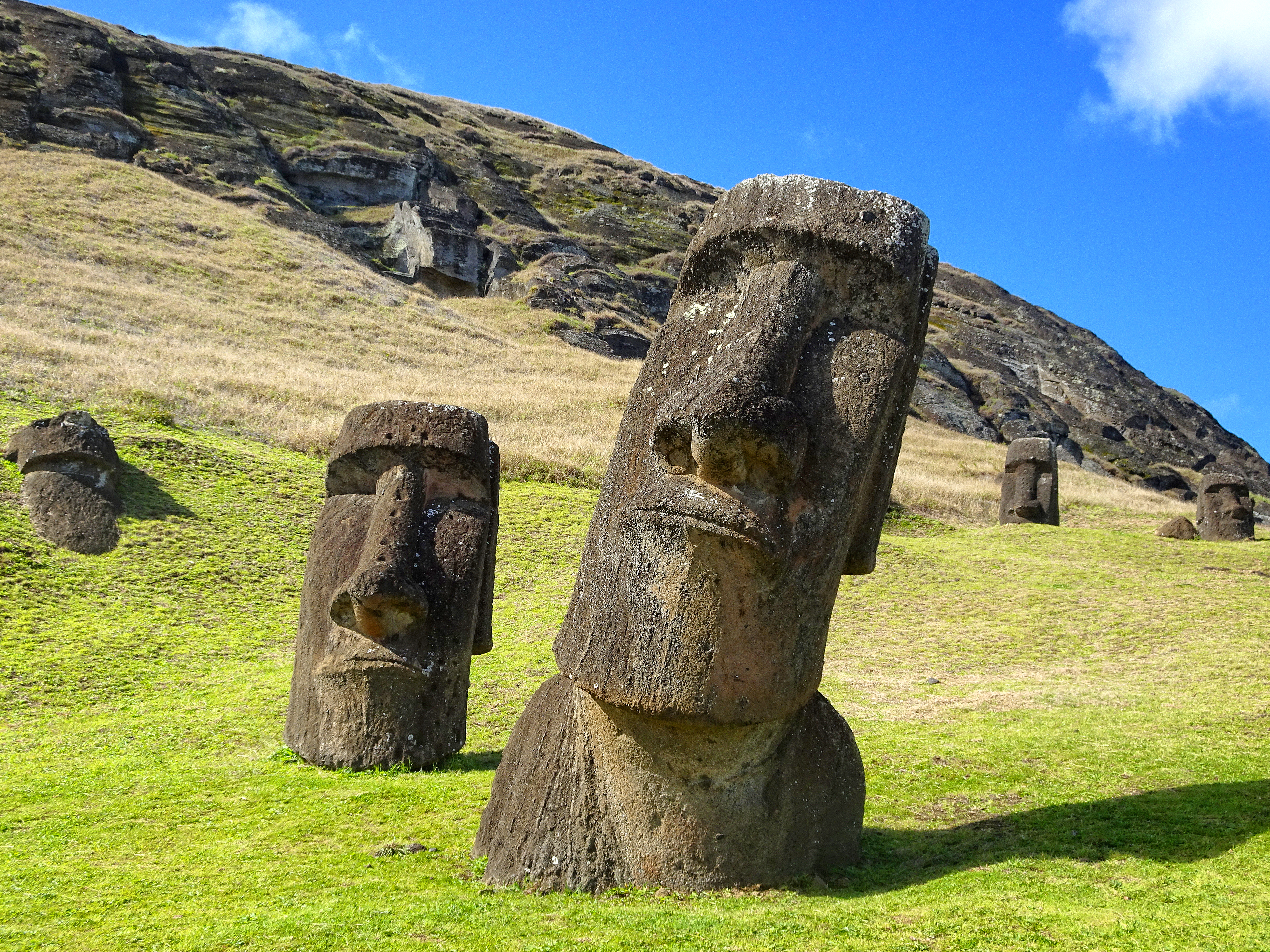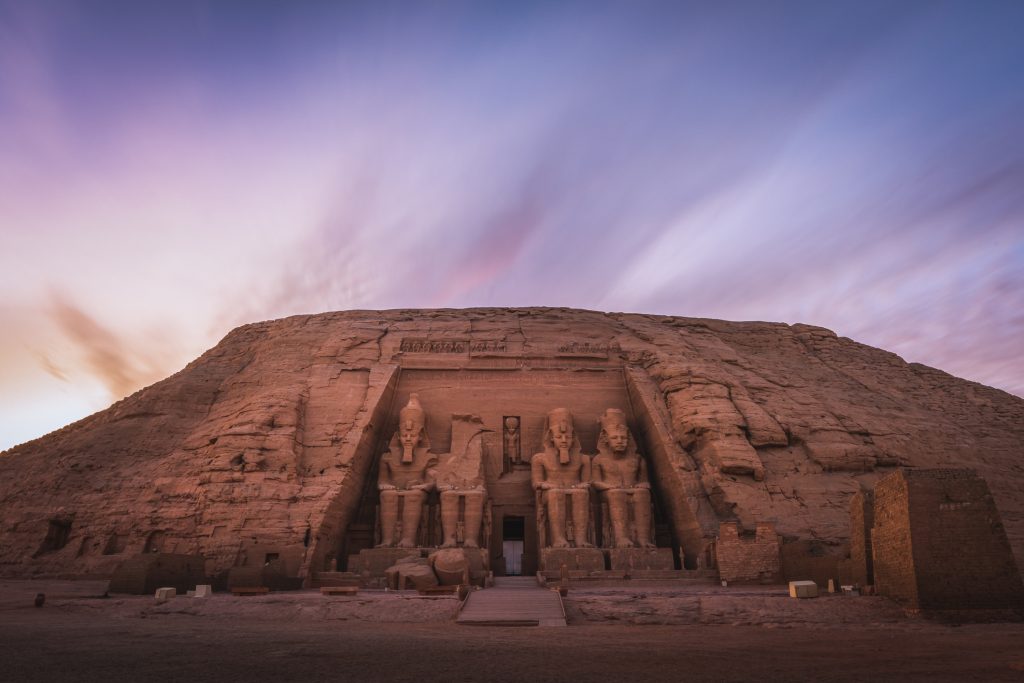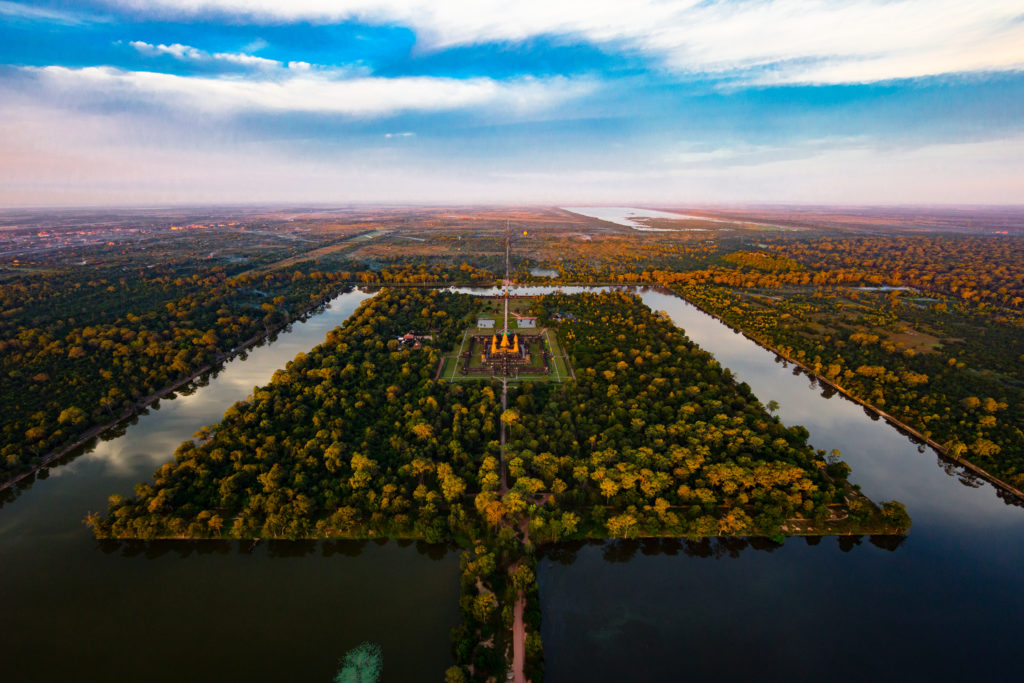From remote islands to the center of continents, there are ancient monuments scattered everywhere across the globe. Many of these have been discovered and explained; yet the majority of them still have question marks looming over them.
Why were so many built? How did the ancients manage such precision and design? Who were the architects responsible for these now famous monuments?
Here’s a list of 15 famous monuments that will blow your mind. Although many are so old they are but fingerprints of their original state, they still are powerful enough to draw our attention and spark our imagination from deep inside.
1. Kailasa Temple, India

Image: The Kailasa Temple is a famous monument located in India.
The Kailasa Temple was carved out of a single piece of rock, making it the largest monolithic structure in the world. If this doesn’t sound impressive enough, the ancient builders are thought to have constructed it vertically, from the top down. It would be like trying to carve an ice sculpture from above!
Estimations vary depending on who you ask, but on average it is thought over 200,000 tonnes of basalt rock was removed as the temple was made.
The famous monument doesn’t stand alone–it is part of a complex of carved cave structures. In total, there are 34 individual temples and monasteries, which are known as the ‘Ellora Caves’. However, it is the sheer size and the intricate and stunning carvings that adorn the Kailasa temple, which make it the most famous monument in the complex.
2. Rock Ship of Masuda, Japan

Image: The famous monument of Masuda, Japan.
Weighing in at an estimated 800 tonnes and carved out of solid granite, the Rock Ship of Masuda is as enigmatic as they come.
This famous monument, located in Asuka, Japan, bears the striking resemblance to a spaceship of some kind. It was discovered atop a steep hill in an area of Japan known for its many rock mounds and carvings. The Rock Ship, which is the largest of the mounds, is 36 feet long and around 15 feet high. Carving this ship would have been a tough enough task for whoever was responsible, yet they made their jobs even more difficult by carving two square openings from the top to the bottom of the monument.
It is still unknown who carved the ship or why, however this famous monument continues to draw interest from travellers all over the world.
3. Baalbek, Lebanon

Image: The temple of Jupiter, Baalbeek, Lebanon. Source
Welcome to Baalbek–home to the largest cut piece of stone ever achieved by human hand.
The carved stone is thought to weigh 1650 tonnes, and still sits unmoved in a nearby quarry. Although this weight is huge, it is not the most mysterious part of the famous monument.
For Baalbek, there are still many questions surrounding its origin. Although it is generally accepted the Romans built part of it, there are many who believe otherwise. Backing this idea up is the fact that the Romans never left any documentation on who commissioned its original structure. There are Roman built areas of Baalbek, but the original giant stone blocks seem beyond the capabilities of even the once mighty Roman Empire.
It has long caused confusion as to why such unnecessarily large blocks were used at all at Baalbek. It seems impractical and unnecessary to our civilization to build with such ridiculously large blocks of stone.
Regardless of who built it, when it was first constructed, and why, it is a truly remarkable famous monument–one that is a puzzling as it is beautiful.
4. Giant Leshan Buddha, China

Image: The famous rock-cut buddha statue in Leshan, China Source
Etched out of a mountainside and standing over 230 feet tall is the largest carved Buddha on the planet. This famous monument, located near the city of Leshan, China, took over 90 years to construct and is now a UNESCO world heritage site.
The Giant Buddha was well worth the effort for the three generations of craftsmen who built it. After it’s completion, it was thought the monument would help calm the fierce waters that ran below its stone feet. This was both symbolic and literal, as passing vessels soon had a calmer path through the river due to the many stones that fell and became submerged during the Buddha’s construction.
5. Star Door, Peru

Image: The Star-door Peru Source
A carved doorway leading nowhere, with nothing but legends left to explain it. This is the mysterious ‘Star Door’, located high in the rugged mountains of Hayu Marca in Southern Peru.
There is so much mystery here. Countless stories exist of the door with many native tribes having names like ‘gateway to the land of the gods’ and ‘the city of the gods’. It seems that stories are all that are left to us, with no one sure of when, why and by whom the door was carved.
In local traditions it is said that there have been many throughout history who have disappeared after approaching the door, never to be seen again. There have also been many strange reports from visitors claiming to have heard music and chanting coming from the solid rock behind the famous monument. Not only this–many have claimed to have seen a strange light phenomenon and objects above and around the star door.
Its purpose may never fully be understood, however this strange monolith still attracts thousands of tourists each year, all of which are drawn in by its mystery.
6. Machu Picchu, Peru

Image: The hidden mountain-top temple of Machu Picchu, Peru. Source
We’ve all heard of Machu Picchu–the city build on top of a mountain. This ancient wonder still attracts millions of visitors each year, making it the most famous monument in all of Peru.
For reasons still unknown, the city was built in an extremely isolated and remote region of South America. How the ancients constructed it without the wheel, modern technology, or even mortar is an engineering anomaly. There is still a functioning canal system found all over Machu Picchu, which has long baffled archaeologists. Canals, fountains, springs and intricate drainage holes are some of the features of the famous monument’s water works.
One of the biggest questions surrounding Machu Picchu is why it was purposely abandoned. There have been no signs of warfare or natural disasters found around the city, raising the notion that that inhabitants left the site by choice sometime in deep antiquity.
7. Göbekli Tepe, Turkey

Image: Gobekli Tepe temple in Turkey Source
The site that shouldn’t exist – Göbekli Tepe is by far the most important archaeological discovery in the history of the planet.
Found in the dry lands of Turkey, this now famous monument has changed everything we thought we knew about modern civilization.
Here are just a few facts about the site that will blow your mind
- It was built over 11000 years ago
- Its construction predates Stonehenge, writing and the invention of the wheel by at least 6000 years
- It is so old it predates the invention of the tools that are supposed to have built it
- It is believed that agriculture was invented there
- The pillars that make up the site are huge, with some standing over 5 meters tall and weighing over 10 tonnes!
- It was purposely buried and remained so for over 9000 years
- It appears just after the North American ice sheet melted–an extremely turbulent time in Earth’s pre-history
8. Easter Island

Image: The Moai Statues of Easter Island. Source
Over 1000 miles of open sea separates Easter Island from its closest neighboring landmass–making the structures on it some of the most isolated on earth.
It is still unknown who exactly is responsible, but at some point over 800 years ago the inhabitants of the island began to carve and erect huge standing stone figures known as ‘Moai’. The statues–over 900 in total–have long captured the imagination of people from all over the world. Each statue stands an average 13 feet tall and weighs around 14 tonnes, with the largest weighing an incredible 70 tonnes.
Many have assumed people from the Americas originally inhabited Easter Island, yet a recent DNA test carried out by archaeologists at the University of Bristol concluded there was no evidence for this. Instead, the researchers found that it was more likely that Polynesians or peoples from Australasia had made their way to the tiny island and decided to construct the stunning figures.
These results only deepen the mystery surrounding the island and the famous monuments left behind. It is still up for debate how the figures were moved, as well as how the materials were excavated from the volcanic crater where the rock was initially quarried.
9. Sascayuaman, Peru

Image: Sascayuaman, Peru Source
The complex of Sascayuaman–a series of megalithic stone walls carved and joined so perfectly that even today you can’t fit a blade of grass in between–bears some of the most impressive architecture on the planet.
The huge carved stones, some of which weighing in at 70 tonnes, have been cut and placed together like puzzle pieces. These stones don’t make up your average wall; they are mismatched and sloped yet somehow all manage to fit together perfectly and without mortar. Undertaking the task of constructing the walls would drive any sane stonemason mad.
The incredible 12-sided stone is one of the most popular parts of this famous monument, with no one being able to explain how this was possibly achieved. The walls of Sascayuaman aren’t built straight or even curved, but instead they zigzag along the earth, making them unique in their style.
10. Moray, Peru

Image: Moray, Peru Source
While Machu Picchu sits in the spotlight for Peru’s most famous monument, Moray quietly rests with just as much mystery surrounding it.
Built high in the Andes Mountains near Cusco, the site sits far from any nearby temples or megalithic structures, it is completely isolated.
While many argue the ancient ruins of Moray were simply an agricultural experiment, there has been much doubt cast on this theory in recent times. Many have concluded that the Incas–known for their advanced knowledge of farming and water systems–would have designed the site to be far more practical for farming than it currently is.
The ancient site, built with a series of concentric circular depressions, has an appearance that resembles a speaker carved into the earth.
This has led some to question the famous monuments acoustic properties, which could help solve the unanswered questions regarding Moray’s purpose. Some researchers have documented extremely loud reverberations when certain frequencies are sung, claiming the nearby mountains come to life with sound and resonance.
11. The Sphinx, Egypt

Image: The Great Sphinx of Giza, Egypt. Source
Few texts, symbols, writing or inscriptions have ever been found documenting who originally built the Sphinx, making its origin completely unknown. This has raised many theories over the years as it is the largest Sphinx found anywhere on Earth.
Carved from a single piece of limestone, the famous monument in Egypt is over 70 meters long and 20 meters high. Its gaze stares eastward, which has made many believe it is in fact an equatorial marker, or a monument that marks important moments during the equinox.
This idea has led many to conclude it was built to signify the constellation Leo–which would mean the great Sphinx was built around 10500 BC–many thousands of years older than its conventional date. This idea is known as the Sphinx Water Erosion Hypothesis and is based on the fact the enclosure surrounding the Sphinx has clearly been eroded by huge amounts of flowing water–the scale of which has not been seen in Egypt since at least 10000 BC.
12. Lalibela, Ethiopia

Image: Lalibela Churches, Ethiopia Source
11 individual churches make up the Ethiopian site of Lalibela, all of which are monoliths carved deep into the bedrock.
The largest of these, Bet Medhane Alemis the biggest rock-hewn hewn church on earth–with an area of over 33 by 23 meters and standing over 11 metres tall. Each church was carved from the top down, which would be an incredible feat even by today’s standards.
One of the most fascinating aspects of the famous monuments at Lalibela is their uncanny resemblance to the Biblical Ark of the Covenant. Because of the similarities in the churches appearance as well as the Ethiopian’s claim to still hold the fabled treasure, there are many who believe this may be true.
By some estimates as much as 40000 people were involved in carving out the churches. Adding further mystery to the site is the fact that no earth or rubble has ever been found in the surrounding area.
Who knows how these incredible famous monuments were built nearly 1000 years ago.
13. Hagar Qim, Malta

Image: Megalithic temples of Hagar Qim, Malta. Source
You wouldn’t know it, but Malta is full of ancient megalithic structures. The most intriguing of these is the site of Hagar Qim, which is thought to have been built between 3500 BC and 2900 BC.
This standing-stone complex comprises of giant standing stone blocks, some of which weigh over 20 tonnes and stand over 20 feet tall.
The most mysterious part of this famous monument is the fact that no advanced civilization was ever thought to have lived on the small archipelago. The sophistication and skill required to construct such a temple is one that seemingly appears out of nowhere.
Not only is it the size and precision of the stone blocks, it is also the advanced astronomy of the site that has historians scratching their heads. Alignments to the summer solstice sunrise and sunset are evident at the ancient site, showing that someone on the small archipelago was correctly tracking the stars over 5000 years ago.
14. Goseck Circle, Germany

Image: Goseck Circle, Germany Source
As this famous monument is precisely orientated to the rising and setting sun on the winter solstice, it is one of the oldest solar observatories on the planet. Constructed nearly 7000 years ago from earth, gravel, stone, and timber, Goseck Circle bears striking resemblance to its UK counterpart ‘Stonehenge,’ yet was built far earlier.
Could this ancient site have been erected by the same civilization?
No one knows for sure who is responsible for Europe’s most intriguing ancient site, yet the unknown culture’s heritage spans deep into prehistory and maybe even beyond.
The earthworks and circular trenches found within Goseck Circle are eerily similar to many sites found across the UK. It is quite the thought trying to image who the culture was who built it, and for what purpose it was intended.
15. Newgrange, Ireland

Image: Newgrange, Ireland Source
Newgrange is without doubt the most famous monument ever found in Ireland. It was made so well in fact–using a mixture of earth, clay, stone, and wood–that it still remains completely waterproof to this day.
Not only is this site extremely large and extremely old, it was made with absolute precision and the utmost care. The site was built in such a way that on the winter solstice, the shortest day of the year, a single beam of light flows through the underground chamber and illuminates a thin 60-foot passageway leading to a central chamber.
This stunning piece of architecture has long caused debate among scholars. How the ancients were able to create such a precise monument so long ago is still not known, and may never be.
The site is one of many examples of henges, stone circles, standing stones, and peculiar megaliths that litter the landscapes of Ireland; which was once home to an advanced civilization lost to history.


 Partially exposed moai at Ranu Raraku on the hillside quarry. Known locally as the moai factory there still remain nearly 400 partially exposed moai.
Partially exposed moai at Ranu Raraku on the hillside quarry. Known locally as the moai factory there still remain nearly 400 partially exposed moai.
























